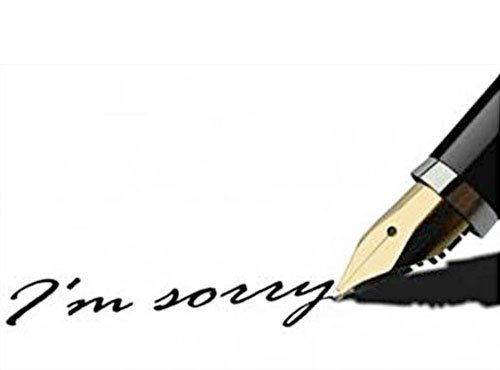
Now here’s a neglected art. We’re all so busy running here and there, treading on each other’s feelings, who has time to write an apology?
Oh, she’ll get over it, we think, and move on to the next meeting, the next crisis and maybe when we bump into the offended party again we might, just might, blurt out a hurried apology: “Hey, sorry for missing our meeting last week, just so much on my plate lately. Catch you later.”
Are we really too busy to write a note?
Or to send an email? No, it’s just that some businesses, in their relentless chase for greater efficiencies and a fatter bottom line, their manners have been forgotten. Their values are now focused on turning a profit, not on creating a great place to work.
If you forget a friend’s birthday, is it okay to say sorry next time you meet? Not if you value her friendship. Your work colleagues may have a less permanent role to play in your life, but their feelings are no less important.
Owing someone an apology, unlike owing them money, is not a debt you can leave until next time you meet. Here’s how to offer an authentic written (or spoken) apology to someone at work that’s honest and sensitive to their feelings. This four-step framework was presented by psychologists Steven Scher and John Darley in the Journal of Psycholinguistic Research:
1st Step: start with an admission
Apologize as soon as you realize you have offended someone. I’m sorry or I apologize are the magic words and must appear first. Example: I’m sorry I forgot to let you know about this morning’s meeting. I feel hugely embarrassed.
2nd Step: own up to the responsibility
Admit your wrong-doing, beware of diluting it with excuses and acknowledge the effect of your behaviour on the other person: No excuses, I simply forgot. You must be furious and rightly so.
3rd Step: offer to make amends
You need to offer appropriate action that will help to soothe the other person’s feelings: If there’s anything I can do to make up for my mistake, please let me know.
4th Step: promise you won’t do it again
Without this undertaking, the offended person has no reason to expect any improvement in your behaviour towards them: I have revised my attendees list for the morning meetings and have moved your name to the top. I have also condensed it into a single-page document which should further reduce the chances of this happening again.
Ask for forgiveness
Depending on the degree to which your actions or omissions have upset the other party, forgiveness may be granted immediately or deferred until you have demonstrated improved behaviour. Demonstrate that you understand this: I know you are still angry with me and that I have to earn your confidence again. I will treat this as an important priority.
Don’t punish yourself
We all make mistakes. It takes courage to admit them and to apologize. It is also character building. You will prove to yourself and to others that you are mature enough to take responsibility for your actions. Your reputation and your integrity will be improved by your willingness to admit that you don’t always get things right.
However, there’s no need to go too far. Assuming you’re guilty only of hurting someone’s feelings, there’s no need to humiliate yourself. Keep the tone of your apology just serious enough that the offended party knows you mean it, but keep in mind that mistakes – and an apology – are part of everyday life.
If you liked, then please subscribe to our YouTube Channel for video content. You can also find us on Twitter, Facebook, Instagram and Linkedin.
You will also like
Read more articles from our weekly series
The Business Mentor





